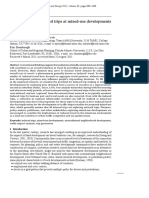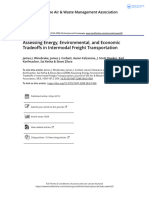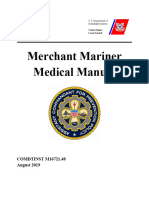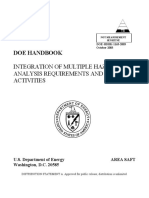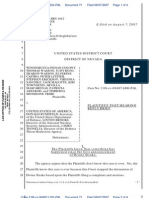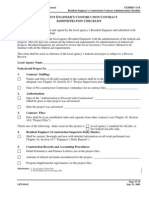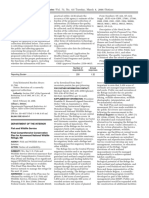0 ratings0% found this document useful (0 votes)
29 viewsA Review of The Representation of Induced Highway Travel in Current Travel and Land Use Models
A Review of The Representation of Induced Highway Travel in Current Travel and Land Use Models
Uploaded by
caaeteThis document reviews how current travel and land use models represent induced highway travel. Case studies of models in Sacramento, Chittenden, and Salt Lake City found that when travel times are fed back between the land use and trip distribution models, the models can represent induced travel effects within documented empirical ranges. The representation of induced travel is important for assessing highway projects' impacts on vehicle travel, emissions, and congestion under the Clean Air Act and National Environmental Policy Act.
Copyright:
© All Rights Reserved
Available Formats
Download as PDF, TXT or read online from Scribd
A Review of The Representation of Induced Highway Travel in Current Travel and Land Use Models
A Review of The Representation of Induced Highway Travel in Current Travel and Land Use Models
Uploaded by
caaete0 ratings0% found this document useful (0 votes)
29 views11 pagesThis document reviews how current travel and land use models represent induced highway travel. Case studies of models in Sacramento, Chittenden, and Salt Lake City found that when travel times are fed back between the land use and trip distribution models, the models can represent induced travel effects within documented empirical ranges. The representation of induced travel is important for assessing highway projects' impacts on vehicle travel, emissions, and congestion under the Clean Air Act and National Environmental Policy Act.
Original Title
2004-UCD-ITS-RR-04-28
Copyright
© © All Rights Reserved
Available Formats
PDF, TXT or read online from Scribd
Share this document
Did you find this document useful?
Is this content inappropriate?
This document reviews how current travel and land use models represent induced highway travel. Case studies of models in Sacramento, Chittenden, and Salt Lake City found that when travel times are fed back between the land use and trip distribution models, the models can represent induced travel effects within documented empirical ranges. The representation of induced travel is important for assessing highway projects' impacts on vehicle travel, emissions, and congestion under the Clean Air Act and National Environmental Policy Act.
Copyright:
© All Rights Reserved
Available Formats
Download as PDF, TXT or read online from Scribd
Download as pdf or txt
0 ratings0% found this document useful (0 votes)
29 views11 pagesA Review of The Representation of Induced Highway Travel in Current Travel and Land Use Models
A Review of The Representation of Induced Highway Travel in Current Travel and Land Use Models
Uploaded by
caaeteThis document reviews how current travel and land use models represent induced highway travel. Case studies of models in Sacramento, Chittenden, and Salt Lake City found that when travel times are fed back between the land use and trip distribution models, the models can represent induced travel effects within documented empirical ranges. The representation of induced travel is important for assessing highway projects' impacts on vehicle travel, emissions, and congestion under the Clean Air Act and National Environmental Policy Act.
Copyright:
© All Rights Reserved
Available Formats
Download as PDF, TXT or read online from Scribd
Download as pdf or txt
You are on page 1of 11
A REVIEW OF THE REPRESENTATION OF INDUCED HIGHWAY
TRAVEL IN CURRENT TRAVEL AND LAND USE MODELS
Caroline J. Rodier, Ph.D.
Research Associate, the Mineta Institude
Post-Doctoral Researcher, California PATH
University of California, Berkeley
1357 S. 46
th
Street. Bldg 452; Richmond, CA 94804-4648
510-231-9472 (O); (916) 451-8188 (F); cjrodier@path.berkeley.edu
Submitted to Transportation Research Board (TRB)
July 2004
Words: 3500
Rodier, 2004 2
ABSTRACT
A considerable body of research on induced travel has emerged over the last several
decades, and induced travel has been acknowledged by the U.S. Transportation Research
Board and Environmental Protection Agency. This has brought renewed attention to the
representation of induced travel in regional land use and travel demand models. A
number of case studies (Sacramento, CA, Chittenden, VT, and Salt Lake City, UT) have
assessed the ability of existing travel and land use models to represent the induced travel
effects of new highway capacity (or elasticity of VMT with respect to lane miles and
travel time). In addition, these studies have conducted sensitivity tests, by turning on and
off model components, to isolate the relative contribution with respect to the models
representation of induced travel. The results indicate that when travel times are fed back
to a land use model and/or the trip distribution step, then (1) models can represent
induced travel within the range documented in the empirical literature and (2) the effect
of new highway capacity on land use and trip distribution can significantly contribute to
the models representation of induced travel. If induced travel is not represented in travel
and land use models, then the need for, and the benefit of, a highway project will tend to
be overstated (e.g., 16% to 236% of vehicle hours traveled), and negative environmental
effects will be understated (e.g., 72% to 192% of NOx vehicle emissions).
INTRODUCTION
A considerable body of research on induced travel has emerged over the last several
decades. As a result of this research, induced travel has been acknowledged by the
Transportation Research Board (1) and the U.S. Environmental Protection Agency (2).
This has brought renewed attention to the ability of regional land use and travel demand
models to represent the effects of induced travel. The representation of induced travel in
current models may have important implications with respect to compliance with the U.S.
Clear Air Act Amendments (CAAA) and the U.S. National Environmental Policy Act
(NEPA).
The CAAA mandate the conformity of state air quality plans and transportation plans to
meet national ambient air quality standards. Non-attainment regions use travel demand
models to demonstrate that aggregate emission levels in their transportation improvement
plans are not greater than the motor vehicle emissions budget in the approved state
implementation plans. If regional travel demand models do not account for the effect of
induced travel, vehicle miles traveled (VMT) and emissions may be underestimated in
transportation plans that include highway capacity expansions. If the requirements of the
CAAA are not met, penalties can be imposed, including the loss of federal funds for
transportation projects, the imposition of stricter requirements, and possible litigation.
NEPA requires Environmental Impact Statements for federal projects to provide
information about the environmental effects of the project and alternatives to decision-
makers and the public. Many highway projects are still justified primarily by estimates
of congestion reduction. However, if a regional travel demand model does not account
for the effects of induced travel, then congestion reduction from the highway project may
be overestimated, and congestion reduction from alternatives (e.g., auto pricing and
2
Rodier, 2004 3
transit) may be underestimated. In addition, analysis of the secondary impacts of
highway projects (e.g., changes in land use) is also required. If a regional travel demand
model does not capture induced effects, then it cannot assess secondary effects.
Most travel demand models account for mode and route shifts associated with induced
travel, but many do not account for other induced travel effects such as changes in land
use, trip generation (or number of trips), and trip distribution (or destination choice). All
of these behavioral responses can alter a travel models estimate of VMT. It is generally
acknowledged that changes in mode choice and route choice are components of induced
demand; however, the importance of land use, trip generation, and destination choice
effects has been a source of controversy (3).
Within the past few years, a number of case studies in different regions of the U.S. have
been conducted to assess how existing travel and land use models can capture the induced
travel effects of new highway capacity in Sacramento (CA), Chittenden (VT), and Salt
Lake City (UT) (4-9). In these studies, current land use and modeling tools are used to
evaluate their ability to represent induced travel (or elasticity of VMT with respect to lane
miles and travel time) by simulating scenarios with and without the highway alternative.
In addition, sensitivity tests are conducted, by turning on and off model components, in
order to isolate the relative contribution of the different induced travel effects represented
in the model (i.e., land development, activity allocation, trip generation, trip distribution,
mode choice, and traffic assignment).
BACKGROUND ON INDUCED TRAVEL
Induced travel is most generally defined as any increase in travel resulting from an
improvement in the transportation system. In the context of the analysis of highway
projects, the improvement in the transportation system would be an increase in the supply
of highway capacity, an increase in auto travel speeds, and a reduction in auto travel
times. These improvements effectively reduce that time cost of auto travel and thus
increase the demand for auto travel.
Induced travel effects evolve over time. In the short term, reduced travel time costs from
new highway capacity affect changes in departure time, route, and mode choice. Near-
term responses to lower travel time costs include changes in destination choices,
frequency of trip-making, and vehicle ownership. Longer-term responses include changes
in the location choice of households and employment activities.
A considerable body of research on induced travel has emerged over the last several
decades (10-19). Research has been conducted to verify the induced travel mechanism
and to gauge the magnitude of its effect. The methodological difficulties encountered in
this research have included data quality, suitability of analytical techniques, and isolation
of causality. It is important to note that such difficulties are shared by almost all areas of
social science research. On balance, however, the weight of the evidence of the research
tends to confirm the existence of induced travel. As a result of this research, induced
3
Rodier, 2004 4
travel has been acknowledged by the Transportation Research Board (1) and the U.S.
Environmental Protection Agency (2).
In the literature, the magnitude of the induced travel effect is most commonly represented
by two elasticity measures:
1. Elasticity of VMT with respect to roadway lane miles. This is typically the
change in VMT divided by the change in lane miles resulting from the highway
project. The empirical literature finds a short-term elasticity that ranges from 0.1
to 0.7 and the long term elasticity that ranges from 0.3 to 1.0 (10-19). For
example, if the elasticity of lane miles with respect to VMT is 1.0, then a 10%
increase in highway lane miles would produce a 10% increase in VMT.
2. Elasticity of VMT with respect to travel time. This is typically the change in
VMT divided by the change in travel times resulting from the highway project.
The empirical literature finds a short-term elasticity that ranges from -0.3 to -0.5
and the long term elasticity that ranges from -0.4 to -11.0 (10-19). For example,
if the elasticity of travel times with respect to VMT is -1.0, then a 10% reduction
in travel times would produce a 10% increase in VMT.
MODELS
For each case study, the models induced travel components and variables are described
in Table 1. In the Sacramento region, tests are conducted on the integrated land use and
transportation model, the Sacramento MEPLAN model, (20-25) and regional travel
demand model, the SACMET model (26). In the Chittenden case study, tests are
conducted on their regional travel demand model link to a land allocation model. In the
Salt Lake City study, tests are conducted on the regional travel demand model. These
models all iterate or feed back modal travel times and/or costs among their sub-models
until convergence (or consistent model input and output of travel time and/or cost) values
are achieved. All of the models in the case studies are official metropolitan planning
organization (MPO) models, with the exception of the Sacramento MEPLAN model.
This model was developed as part of a model comparison project at the University of
California at Davis (25). However, an updated version of the Sacramento MEPLAN
model has now been adopted by the MPO for use with the SACMET model.
4
Rodier, 2004 5
TABLE 1. Induced travel components and variables in the case study models.
SACRAMENTO (CA)
INDUCED TRAVEL MODEL
COMPONENTS
MEPLAN SACMET
CHITTENDEN
(VT)
SALT LAKE
CITY (UT)
Land Development
(acres of land developed)
Modal travel
time & cost
Activity Allocation
(where urban activities locate)
Modal travel
time & cost
Modal travel
time & cost
Trip Distribution
(origin and destination of trip)
Modal travel
time & cost
Modal travel
time & cost for
work trips; auto
times for others
Modal travel
time & cost
Auto travel
time & cost
Mode Choice
(mode use in trip)
Modal travel
time & cost
Modal travel
time & costs
Modal travel
time & cost
Modal travel
time & costs
Traffic Assignment
(route/road taken for trip)
Modal travel
time & cost
Auto travel times Modal travel
time & cost
Auto travel
times
Shaded areas indicate absence of model components.
SCENARIOS
Sensitivity tests are developed to assess the contribution of each model step to the
models total representation of induced travel in the network scenarios. This is
accomplished by turning on and off different model steps. An illustration of the
sensitivity tests is provided in Table 2. The first sensitivity test A is simulated with the
full model to represent all induced travel effects. Each subsequent sensitivity test (B to
D) drops an addition sub-model component by holding it constant from the no-build
scenario. For example, sensitivity test B holds land uses constant from the no-build
scenario and simulates only the trip distribution, mode choice, and traffic assignment
induced travel effects of the highway scenario.
TABLE 2. An example of induced travel sensitivity tests for highway scenario.
INDUCED TRAVEL
MODEL COMPONENTS
TEST A TEST B TEST C TEST D
Land Use
No-build land uses No-build land uses No-build land uses
Trip Distribution
No-build trip tables No-build trip tables
Mode Choice
No-build mode
choice
Traffic Assignment
Shaded areas indicate model components held constant from the no-build.
5
Rodier, 2004 6
RESULTS
The results of the simulation tests with the Sacramento integrated land use and
transportation (MEPLAN) model (4) indicated that change in land use patterns from the
new highway capacity over a twenty-year time horizon accounted for half of predicted
induced travel and that the change in trip origin-destination patterns (or trip distribution
component) accounted for the other half. Overall, the models long-term representation
of induced travel (elasticity of VMT with respect to lane miles) for new highway projects
was 0.8. This figure is consistent with the high end of the empirical range in the
literature (as described above). The percentage underestimation of the travel and
emission effects from the highway to the no-build with and without full model feedback
would be 102% for VMT and 192% for NOx emissions. See Table 3 below.
TABLE 3. Long-term induced travel sensitivity test results with the case study models.
SACRAMENTO (CA) HIGHWAY
ALTERNATIVES
MEPLAN SACMET
CHITTENDEN
(VT)
SALT LAKE
CITY (UT)
ELASTICITY OF VMT
0.8 (lane miles)
0.23 (lane miles)
-0.41 (travel
time)
0.76 (lane miles)
-0.66 (travel time)
0.78 (lane miles)
SUBMODEL ELASTICITY
CONTRIBUTION
Land Development 25% (lane miles)
Activity Allocation
25% (lane miles)
-1% (lane miles)
2% (travel time)
Trip Distribution
50% (lane miles)
113% (lane
miles)
112% (travel
time)
71% (lane miles)
76% (travel time)
53% (lane miles)
Mode Choice
0% (lane miles)
-4% (lane miles)
-17% (travel
time)
-1% (lane miles)
0% (travel time)
-1% (lane miles)
Traffic Assignment
0% (lane miles) -9% (lane miles)
5% (travel time)
32% (lane miles)
23% (travel time)
47% (lane miles)
PERCENTAGE UNDER-
ESTIMATE: NO FEED BACK
Vehicle Miles Traveled
(VMT)
102% 94% 70% 85%
Vehicles Hours Traveled
(VHT)
16% 236%
NOx emissions
192% 72%
Shaded areas indicate an absence of results.
6
Rodier, 2004 7
Similar simulation tests were conducted with the regions travel demand model
(SACMET), which does not include a land use component (5). These results indicated
that, for a twenty year time horizon, the model predicted an elasticity of VMT with
respect to land miles of 0.23 and an elasticity of VMT with respect to travel time of
-0.41. These figures are consistent with the very low end of the empirical elasticity range
described above. In addition, the sensitivity tests indicated that the change in origin-
destination trip patterns from the highway projects (enabled by full feedback to trip
distribution) accounted for almost all of the models representation of induced travel.
The negative results for mode choice and traffic assignment suggest that this model
would forecast a reduction in VMT relative to the no-build without full feedback. The
percentage underestimation of the travel and emission effects from the highway to the no-
build with and without full model feedback would be 94% for VMT, 16% for vehicle
hours of travel (VHT), and 192% for NOx emissions.
Another approach was taken to access the Sacramento travel demand models prediction
of induced travel (6, 7). This study used a historical forecasting validation technique to
estimate actual induced travel in the region over a ten-year period (elasticity of VMT
with respect to lane miles was found to be 0.22). This result was compared to the
models prediction of induced travel (elasticity of 0.14). Thus, the model tended to
underestimate induced travel by 36% over a ten-year time horizon.
The results of the Chittendon County (VT) case study (8) indicate that the trip
distribution component accounted for almost 75% and that the traffic assignment
component accounted for almost 25% of the models representation of induced travel.
The elasticity of VMT with respect to lane miles was 0.76 and with respect to travel time
was -0.66. The land use effect in this scenario was negligible. Over the twenty-five-year
time horizon, additional roadway miles are projected to be only about one tenth of the
growth in households and employment. As a result, the congestion effect (due to
population growth) on the networks tends to swamp any increase in capacity. However,
even without significant land use effects, the percentage underestimation of the travel
effects from the highway to the no-build with and without full model feedback would be
70% for VMT and 236% for VHT.
The Salt Lake Citys (UT) case study (9) indicates that the changes in trip distribution
and traffic assignment from the new highway project each accounted for about 50% of
the models prediction of induced travel. The elasticity of VMT with respect to lane
miles for the highway alternative was 0.78. The percentage underestimation of the travel
from the highway to the no-build with and without full model feedback would be 85% for
VMT.
SUMMARY AND CONCLUSIONS
Induced travel in the context of highway capacity expansion projects refers to the
reduction in the time cost of travel and the resulting in increase in travel demand. The
existence of induced travel has been acknowledged by the scientific research community.
7
Rodier, 2004 8
In the empirical literature, the elasticity of VMT with respect to lane miles, the most
common measure of induced travel in the literature, ranges from 0.3 to 1.0 in the long-
run. Thus, if a highway project increases the total lane miles in the region by 10%, then
VMT in the region may be increased by 3.0% to 10%.
The body of literature on the ability of existing travel and land use models to represent
induced travel indicates that when travel times are fed back to a land use model and/or
the trip distribution step, then (1) models can represent induced travel within the range
documented in the empirical literature and (2) the effect of new highway capacity on land
use and trip distribution significantly contributes to the models representation of induced
travel. If induced travel is not represented in travel and land use models, then the need
for, and the benefit of, the project will be overstated (e.g., 16% to 236% of VHT), and
negative environmental effects will be understated (e.g., 72% to 192% of NOx
emissions).
ACKNOWLEDGEMENTS
The author would like to thank the U.S. Environmental Protection Agency and the
Mineta Institute for their support of this research. A special thank you goes to Robert
J ohnston at the University of California at Davis for his contributions to our past work on
alternative scenario analyses with urban models. J ohn Abraham and Doug Hunt also are
thanked for their continued work on the Sacramento MEPLAN model and their advice on
its application. Thanks you to Gordon Garry at the Sacramento Area Council of
Governments for his continued support of modeling research with the Sacramento
models. Finally, a special thanks goes to Roger Gorham (currently) and Lewison Lem
(formerly) at the U.S. Environmental Protection Agency for all their important comments
and contributions to this study. The contents of this paper reflect the views of the author
who is responsible for the facts and the accuracy of the data presented.
8
Rodier, 2004 9
REFERENCES
1. Transportation Research Board. 1995. Expanding Metropolitan Highways:
Implications for Air Quality and Energy Use: Special report 245. Washington,
D.C.: National Research Council, National Academy Press.
2. United States Environmental Protection Agency. 2000. Induced Travel: A
Review of Recent Literature with a Discussion of Policy Issues. Washington
D.C.: US EPA. http://www.epa.gov/tp/rap.htm.
3. DeCorla-Souza, P. and Cohen, H. 1998. Accounting for Induced Travel in
Evaluation of Metropolitan Highway Expansion. Preprint for the 77
th
Annual
Meeting of the Transportation Research Board. National Research Council,
Washington, D.C.
4. Rodier, Caroline J ., J ohn E. Abraham and Robert A. J ohnston. 2001. Anatomy
of Induced Travel Using An Integrated Land Use and Transportation model in
the Sacramento Region. Preprint for the 79
th
Annual Meeting of the
Transportation Research Board.
5. Rodier, C. J . 2002. A Case Study of Induced Travel in the Sacramento region.
Final Report for the Environmental Protection Agency. December.
6. Rodier, C. J . 2003. Verifying the Accuracy of Regional Models Used in
Transportation and Air Quality Planning. Report for the Mineta Transportation
Institute. J anuary.
7. Rodier, C. J . 2004. Verifying the Accuracy of Regional Models Used in
Transportation and Air Quality Planning. Transportation Research Record. In
press.
8. Marshall, N. and B. Grady. 2001. Induced Travel Results. Resource Systems
Group for the U.S. Environmental Protection Agency.
9. Cambridge Systematics. 2003. Wasatch Frong Regional Council (WFRC) Model
Sensitivity Testing and Training Study. Utah Department of Transportation.
10. Cervero, Robert. 2001. Road Expansion, Urban Growth, and Induced Travel:
A PATH Analysis. Department of City and Regional Planning, University of
California, Berkeley.
11. Cervero, Robert and Mark Hansen. 2000. Road Supply-Demand Relationships:
Sorting Out Causal Linkages. Institute of Transportation Studies, University
of California, Berkeley.
12. Fulton, Lewis M., Robert B. Noland, Daniel J . Meszler and J ohn V. Thomas.
2000. A Statistical Analysis of Induced Travel Effects in the U.S. Mid-Atlantic
Region. Journal of Transportation and Statistics 3(1): 1-14.
9
Rodier, 2004 10
13. Goodwin, Phil. 1996. Empirical evidence on induced traffic, a review and
synthesis. Transportation 23 (1996): 35-54.
14. Hansen, Mark, David Gillen, Allison Dobbins, Yuanlin Huang and Mohnish
Puvathingal. 1993. The air quality impacts of urban highway capacity
expansion: traffic generation and land use change. Institute of Transportation
Studies, University of California, Berkeley.
15. Hansen, Mark and Yuanlin Huang. 1997. Road supply and traffic in California
urban areas. Transportation Research A 31A No. 3 (May 1997): 205-218.
16. Noland, Robert. 2001. Relationships Between Highway Capacity and Induced
Vehicle Travel. Transportation Research A 35(1).
17. Noland, Robert and William Cowart. 2000. Analysis of metropolitan highway
capacity and the growth in vehicle miles of travel. Transportation 27(4)
(Winter 2000): 363-390.
18. Noland, Robert and Lewison Lem. 2001. A Review of the Evidence for
Induced Travel and Changes in Transportation and Environmental Policy in the
United States and the United Kingdom. Transportation Research D 7(1).
19. Standing Advisory Committee on Trunk Road Assessment. 1994. Trunk Roads
and the Generation of Traffic. London: Department of Transport.
20. Hunt J .D. and Simmonds D.C. 1993. Theory and application of an integrated
land-use and transport modelling framework, Environment and Planning B
20:221-244.
21. Hunt J . D., and Echenique, M. H. 1993. Experiences in the application of the
MEPLAN framework for land use and transportation interaction modeling.
Proceedings of the 4
th
National Conference on the Application of Transportation
Planning Methods, Daytona Beach, Florida, USA, (May), 723-754.
22. Hunt, J . D. 1994. Calibrating the Naples land use and transport model.
Environment and Planning 21B, 569-590.
23. Abraham, J . E. 2000. Parameter Estimation in Urban Models: Theory and
Application to a Land Use Transport Interaction Model of the Sacramento,
California Region. Diss. University of Calgary, Canada.
24. Abraham, J . E. and Hunt J . D. 2001. Comparisons Policy Analysis using the
Sacramento Land Use Transportation Interaction Model. Transportation
Research Record.
10
Rodier, 2004 11
25. Hunt J . D., R. A. J ohnston, J . E. Abraham, C. J . Rodier, G. Garry, S. H. Putnam,
and T. de la Barra. 2001. Comparisons from the Sacramento Model Test-bed.
Transportation Research Record.
26. DKS & Associates. 1994. SACMET Regional Travel Demand Model Version 94.0:
Model Development and User Reference Report. SACOG. Sacramento, CA.
11
You might also like
- River and Stream Pollution Case - Spanish Waste Water Spill - 1998Document11 pagesRiver and Stream Pollution Case - Spanish Waste Water Spill - 1998OPGJrNo ratings yet
- Fish Protection at Water DiversionsDocument480 pagesFish Protection at Water DiversionsAminudin ArifNo ratings yet
- JR - A Revw of The Reprsnt of Induced Highwy Travl in Current Travl & Land Use MDLDocument12 pagesJR - A Revw of The Reprsnt of Induced Highwy Travl in Current Travl & Land Use MDLochaerryNo ratings yet
- ITS and Traffic Management: M. PapageorgiouDocument60 pagesITS and Traffic Management: M. PapageorgiouShubham ShekharNo ratings yet
- Impact of Stops For Bus Delays On RoutesDocument12 pagesImpact of Stops For Bus Delays On Routessobisol660No ratings yet
- Crossing The Bridge The Effects of Time Varying Tolls On Curbing Congestion 2016 Transportation Research Part A Policy and PracticeDocument19 pagesCrossing The Bridge The Effects of Time Varying Tolls On Curbing Congestion 2016 Transportation Research Part A Policy and PracticeZen ZeeNo ratings yet
- Time-Use Data, Analysis and Modeling Toward The Next Generation of Transportation Planning MethodologiesDocument11 pagesTime-Use Data, Analysis and Modeling Toward The Next Generation of Transportation Planning MethodologiesRidhima4No ratings yet
- 2020 - Can Segregating Vehicles in Mixed-Traffic Stream Improve Safety and Throughput - Implications Using SimulationDocument26 pages2020 - Can Segregating Vehicles in Mixed-Traffic Stream Improve Safety and Throughput - Implications Using SimulationAgothiNo ratings yet
- 10 - 6 - 2019 - A PassingDocument15 pages10 - 6 - 2019 - A PassingShiven LohadiyaNo ratings yet
- Impact of Transit-Pass Ownership On Daily Number of TripsDocument9 pagesImpact of Transit-Pass Ownership On Daily Number of TripsFariha AktarNo ratings yet
- 提高墨西哥高速公路几何设计标准Document14 pages提高墨西哥高速公路几何设计标准zjq1432031523No ratings yet
- A Global High Shift Scenario: Impacts and Potential For More Public Transport, Walking, and Cycling With Lower Car UseDocument18 pagesA Global High Shift Scenario: Impacts and Potential For More Public Transport, Walking, and Cycling With Lower Car UseMichael ReplogleNo ratings yet
- A Case Study Mixed-UseDocument14 pagesA Case Study Mixed-Useविपेन्द्र चौहान विपिनNo ratings yet
- Multiplezacion de TDocument23 pagesMultiplezacion de TAnonymous 17QVkHUnVlNo ratings yet
- 1986 Paterson PDFDocument11 pages1986 Paterson PDFromulozgNo ratings yet
- Sustainability 12 09717Document20 pagesSustainability 12 09717Animesh SinghNo ratings yet
- Analysis of Work Zone Traffic Behavior For Planning ApplicationsDocument18 pagesAnalysis of Work Zone Traffic Behavior For Planning Applicationsanubhavchattaraj337No ratings yet
- Indicators For Sustainable Transportation Planning: Robert A. JohnstonDocument9 pagesIndicators For Sustainable Transportation Planning: Robert A. JohnstonMuhamet AhmetiNo ratings yet
- On Street Parking On Street RoadsDocument23 pagesOn Street Parking On Street RoadsfmalagapNo ratings yet
- Cover SheetDocument18 pagesCover Sheetzaheer0406No ratings yet
- 2000 Holguin-Veras e ThorsoDocument12 pages2000 Holguin-Veras e ThorsothiagocanhosNo ratings yet
- Acceleration ModelsDocument96 pagesAcceleration ModelsSourav DasNo ratings yet
- Effect of Vehicle Composition and Delay On Roundabout Capacity Under Mixed Traffic ConditionsDocument8 pagesEffect of Vehicle Composition and Delay On Roundabout Capacity Under Mixed Traffic ConditionsasdNo ratings yet
- Transportation ModelsDocument65 pagesTransportation ModelsAnas R. Abu KashefNo ratings yet
- Adjusting ITEs Trip Generation Handbook For UrbanDocument26 pagesAdjusting ITEs Trip Generation Handbook For UrbandiscolettoNo ratings yet
- 1 s2.0 S0967070X23000331 MainDocument8 pages1 s2.0 S0967070X23000331 MainHUY NGÔ NHẤTNo ratings yet
- CVEN3031: PROJECT#2 - Literature Review: Hong-Sanh Hua Z5076315 UNSWDocument5 pagesCVEN3031: PROJECT#2 - Literature Review: Hong-Sanh Hua Z5076315 UNSWHong J HuwuaNo ratings yet
- VKT Level and Distribution of Land UsesDocument10 pagesVKT Level and Distribution of Land Usessoltani9432No ratings yet
- Analysis of The Efficiency of Urban Commercial Vehicle Toursdata Collection, Methodology, and Policy ImplicationsDocument19 pagesAnalysis of The Efficiency of Urban Commercial Vehicle Toursdata Collection, Methodology, and Policy ImplicationstaniNo ratings yet
- Traffic Flow Prediction and Air Quality Monitoring in Smart CitiesDocument5 pagesTraffic Flow Prediction and Air Quality Monitoring in Smart CitiesVedant ChindheNo ratings yet
- A Queuing Model For Mixed Traffic Flows On HighwaysDocument13 pagesA Queuing Model For Mixed Traffic Flows On HighwaysSyella MunawarNo ratings yet
- 2015 - Ucd Its RP 15 81 PDFDocument4 pages2015 - Ucd Its RP 15 81 PDFBush B ThomasNo ratings yet
- Interchange Crash Analysis by Type On Florida Highways: Doreen Kobelo PH.DDocument10 pagesInterchange Crash Analysis by Type On Florida Highways: Doreen Kobelo PH.Dwww.irjes.comNo ratings yet
- An Analysis of Metro Ridership at The Station-To-Station Level in SeoulDocument18 pagesAn Analysis of Metro Ridership at The Station-To-Station Level in SeoulAlok MandalNo ratings yet
- Pedestrian Flow Analysis at Uncontrolled Intersection - A Case StudyDocument21 pagesPedestrian Flow Analysis at Uncontrolled Intersection - A Case StudyAnil ParmarNo ratings yet
- Commuter Preferences For A First Mile Last Mi 2023 Transportation Research PDocument23 pagesCommuter Preferences For A First Mile Last Mi 2023 Transportation Research PJose Luis Moreno GomezNo ratings yet
- Estimating Traffic Volume On Wyoming Low Volume Using Regresion Ang Logistic Regression ModelDocument14 pagesEstimating Traffic Volume On Wyoming Low Volume Using Regresion Ang Logistic Regression ModelRamadan DurakuNo ratings yet
- Ijtte 2012 CongestionDocument20 pagesIjtte 2012 CongestionAafan ShahidNo ratings yet
- Assesing The Accesibility Impact of Transport Policy by Land UseDocument10 pagesAssesing The Accesibility Impact of Transport Policy by Land UseandrianNo ratings yet
- Design of A Survey To Assess Prospects For Consumer Electric Mobility in Canada: A Retrospective AppraisalDocument28 pagesDesign of A Survey To Assess Prospects For Consumer Electric Mobility in Canada: A Retrospective AppraisalMasimba TutsiraiNo ratings yet
- 2006 Freight Data Assembling and Modeling Methodologies and PracticeDocument33 pages2006 Freight Data Assembling and Modeling Methodologies and PracticeQisheng PanNo ratings yet
- 0.1 Multiple Equilibrium Behaviors Considering Human Exposure ToDocument11 pages0.1 Multiple Equilibrium Behaviors Considering Human Exposure ToXia YangNo ratings yet
- Travel Behaviour, Regeneration and Planning PolicyDocument49 pagesTravel Behaviour, Regeneration and Planning PolicyDr Firas AsadNo ratings yet
- Household Vehicle Type Holdings and Usage An Application MDCEVDocument19 pagesHousehold Vehicle Type Holdings and Usage An Application MDCEVAndrean MaulanaNo ratings yet
- Case StudyDocument12 pagesCase StudyMikaNo ratings yet
- Paper 11 PDFDocument15 pagesPaper 11 PDFsebastianNo ratings yet
- Impact of Trac Congestion On Road Accidents: A Spatial Analysis of The M25 Motorway in EnglandDocument23 pagesImpact of Trac Congestion On Road Accidents: A Spatial Analysis of The M25 Motorway in EnglandSmith SongkhlaNo ratings yet
- Paper Nina PDFDocument12 pagesPaper Nina PDFGianinna González ZepedaNo ratings yet
- Factors That Influence Urban Streetcar RDocument8 pagesFactors That Influence Urban Streetcar RDe'Von JNo ratings yet
- Jot1011 PDFDocument94 pagesJot1011 PDFHarry NovfriandiNo ratings yet
- Assessing Energy Environmental and Economic Tradeoffs in Intermodal Freight TransportationDocument11 pagesAssessing Energy Environmental and Economic Tradeoffs in Intermodal Freight TransportationTâm MinhNo ratings yet
- 1 s2.0 S1361920922000050 Main PDFDocument17 pages1 s2.0 S1361920922000050 Main PDFSimran SrgcNo ratings yet
- Valuing Crowding in Public Transport Implications For Costbenefit AnalysisDocument21 pagesValuing Crowding in Public Transport Implications For Costbenefit AnalysisDiego GaldinoNo ratings yet
- Potential Effect of Traffic Signalling System in Catbalogan City, PhilippinesDocument16 pagesPotential Effect of Traffic Signalling System in Catbalogan City, PhilippinesJON-KARLO ANICETENo ratings yet
- Mapping Jurnal 3Document2 pagesMapping Jurnal 3ademaiditaaaaa25No ratings yet
- This Paper Has Been Mechanically Scanned. Some Errors May Have Been Inadvertently IntroducedDocument20 pagesThis Paper Has Been Mechanically Scanned. Some Errors May Have Been Inadvertently IntroducedkurianpappsNo ratings yet
- Tools For Estimating VMT Reductions From Built Environment ChangesDocument36 pagesTools For Estimating VMT Reductions From Built Environment ChangeskahtanNo ratings yet
- JR - Aplic of Bayesian Melding To Alaska Way ViaductDocument14 pagesJR - Aplic of Bayesian Melding To Alaska Way ViaductverdantoNo ratings yet
- Travel Demand Analysis: Requirements For Transit Modeling For Metropolitan ManilaDocument20 pagesTravel Demand Analysis: Requirements For Transit Modeling For Metropolitan ManilaJR CaberteNo ratings yet
- A Modified Post Encroachment Time Model of Urban Road Merging Area Based On Lane-Change CharacteristicsDocument12 pagesA Modified Post Encroachment Time Model of Urban Road Merging Area Based On Lane-Change CharacteristicsSakshi ShekharNo ratings yet
- 1 s2.0 S0191261510000226 MainDocument22 pages1 s2.0 S0191261510000226 MainDamoonAzadNo ratings yet
- Highway-Rail Grade Crossing Identification and Prioritizing Model DevelopmentFrom EverandHighway-Rail Grade Crossing Identification and Prioritizing Model DevelopmentNo ratings yet
- Navy Submarine EM/TEMPEST Falsification FacilityDocument274 pagesNavy Submarine EM/TEMPEST Falsification FacilityMossad News100% (1)
- Notice: Agency Information Collection Activities Proposals, Submissions, and ApprovalsDocument2 pagesNotice: Agency Information Collection Activities Proposals, Submissions, and ApprovalsJustia.comNo ratings yet
- USCG Merchant Marine Medical Manual - Aug 2019 - CIM - 16721 - 48Document297 pagesUSCG Merchant Marine Medical Manual - Aug 2019 - CIM - 16721 - 48Mark Alvin TanNo ratings yet
- Platte To Park Hill Stormwater Systems Fact SheetDocument3 pagesPlatte To Park Hill Stormwater Systems Fact SheetMichael_Lee_RobertsNo ratings yet
- Doe Handbook: Integration of Multiple Hazard Analysis Requirements and ActivitiesDocument37 pagesDoe Handbook: Integration of Multiple Hazard Analysis Requirements and ActivitiesMarco RangelNo ratings yet
- Construction in Cities Social, Environmental, Political, and EconomicDocument270 pagesConstruction in Cities Social, Environmental, Political, and EconomicDjamelBellahceneNo ratings yet
- 2017-04-09 Letter To EPA Re PSD ExtensionDocument34 pages2017-04-09 Letter To EPA Re PSD ExtensionAngel GonzalezNo ratings yet
- USCG PSC ProceduresDocument1,231 pagesUSCG PSC ProceduresShivaramHariharan100% (1)
- Yazoo Backwater Area DEISDocument179 pagesYazoo Backwater Area DEISAnthony WarrenNo ratings yet
- Aphis 2013 0042 0050Document223 pagesAphis 2013 0042 0050Mark ReinhardtNo ratings yet
- ôn thi Đại học môn Anh PRACTICE TEST 68,69,70Document10 pagesôn thi Đại học môn Anh PRACTICE TEST 68,69,70tran Lan PhuongNo ratings yet
- Divine Strake (Robert Hager) Plaintiff's Post-Hearing Reply BriefDocument4 pagesDivine Strake (Robert Hager) Plaintiff's Post-Hearing Reply Briefscribd3No ratings yet
- Certified Copy Issued On 8/18/2017: PetitionerDocument27 pagesCertified Copy Issued On 8/18/2017: PetitionerNick ReismanNo ratings yet
- Maryland Motion To Expedite - Purple Line Lawsuit - July 3, 2017 FilingDocument24 pagesMaryland Motion To Expedite - Purple Line Lawsuit - July 3, 2017 FilingAJ MetcalfNo ratings yet
- Notice: Endangered and Threatened Species: Anadromous Fish Take— Middle Columbia River SteelheadDocument3 pagesNotice: Endangered and Threatened Species: Anadromous Fish Take— Middle Columbia River SteelheadJustia.com100% (1)
- Strategic Environment ManagementDocument15 pagesStrategic Environment Managementhaidil abd hamidNo ratings yet
- EMJ - 991 FC - Indd 991 8/7/20 3:43 PM 8/7/20 3:43 PMDocument100 pagesEMJ - 991 FC - Indd 991 8/7/20 3:43 PM 8/7/20 3:43 PMFannyng RoncalNo ratings yet
- Perceiving Environmental Quality: Research and ApplicationsDocument308 pagesPerceiving Environmental Quality: Research and ApplicationsShalom JCNo ratings yet
- Ministry of Environment and Water Management Romania - Regional Waste Management Plan - Region 1Document164 pagesMinistry of Environment and Water Management Romania - Regional Waste Management Plan - Region 1mihai_iosifNo ratings yet
- Transit Noise and Vibration Impact Assessment Manual Fta Report No 0123 - 0 PDFDocument258 pagesTransit Noise and Vibration Impact Assessment Manual Fta Report No 0123 - 0 PDFKamrul HasanNo ratings yet
- Metro Response To Hazard Assessment Study by ExponentDocument44 pagesMetro Response To Hazard Assessment Study by ExponentMetro Los AngelesNo ratings yet
- Prohibited Personnel Practices Report, OSC File No. MA-16-1931Document21 pagesProhibited Personnel Practices Report, OSC File No. MA-16-1931FedSmith Inc.No ratings yet
- Michael Bishop Complaint For Declaratory Relief and Petition For Writ of MandamusDocument19 pagesMichael Bishop Complaint For Declaratory Relief and Petition For Writ of MandamusSteve HornNo ratings yet
- Petition For ReconsiderationDocument5 pagesPetition For ReconsiderationStatesman JournalNo ratings yet
- Baltimore Gas and Electric Co V NDRC DigestDocument1 pageBaltimore Gas and Electric Co V NDRC DigestsobranggandakoNo ratings yet
- Resident Engineer Check ListDocument4 pagesResident Engineer Check ListTeh Swee LoonNo ratings yet
- Strycker's Bay Vs KarlenDocument1 pageStrycker's Bay Vs KarlenMia VinuyaNo ratings yet
- Notice: Final Comprehensive Conservation Plan For Arrowwood National Wildlife Refuge, North DakotaDocument2 pagesNotice: Final Comprehensive Conservation Plan For Arrowwood National Wildlife Refuge, North DakotaJustia.comNo ratings yet












